Kami are the deities, divinities, spirits, phenomena or "holy powers" that are venerated in the Shinto religion. They can be elements of the landscape, forces of nature, or beings and the qualities that these beings express; they can also be the spirits of venerated dead people. Many kami are considered the ancient ancestors of entire clans. Traditionally, great leaders like the Emperor could be or became kami.

Kasuga-taisha (春日大社) is a Shinto shrine in Nara, Nara Prefecture, Japan. It is the shrine of the Fujiwara family, established in 768 CE and rebuilt several times over the centuries. The interior is famous for its many bronze lanterns, as well as the many stone lanterns that lead up the shrine.

A mikoshi (神輿) is a sacred religious palanquin. Shinto followers believe that it serves as the vehicle to transport a deity in Japan while moving between main shrine and temporary shrine during a festival or when moving to a new shrine. Often, the mikoshi resembles a miniature building, with pillars, walls, a roof, a veranda and a railing.

Yasaka Shrine, once called Gion Shrine, is a Shinto shrine in the Gion District of Kyoto, Japan. Situated at the east end of Shijō-dōri, the shrine includes several buildings, including gates, a main hall and a stage. The Yasaka shrine is dedicated to Susanoo in the tradition of the Gion faith as its chief kami, with his consort Kushinadahime on the east, and eight offspring deities on the west. The yahashira no mikogami include Yashimajinumi no kami, Itakeru no kami, Ōyatsuhime no kami, Tsumatsuhime no kami, Ōtoshi no kami, Ukanomitama no kami, Ōyatsuhiko no kami, and Suseribime no mikoto.
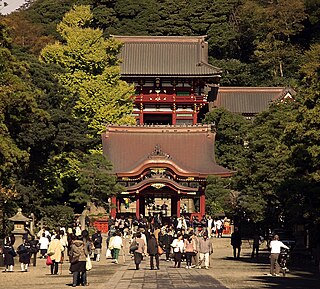
Tsurugaoka Hachimangū (鶴岡八幡宮) is the most important Shinto shrine in the city of Kamakura, Kanagawa Prefecture, Japan. The shrine is a cultural center of the city of Kamakura and serves as the venue of many of its most important festivals with two museums.
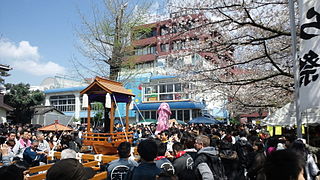
The Shinto Kanamara Matsuri is an annual Japanese festival held each spring at the Kanayama Shrine in Kawasaki, Japan. The exact dates vary: the main festivities fall on the first Sunday in April. The phallus, as the central theme of the event, is reflected in illustrations, candy, carved vegetables, decorations, and a mikoshi parade. The shrine is part of the Wakamiya Hachimangu Shrine and located near Kawasaki-Daishi Station.
Shrine Shinto is a form of the Shinto religion. It has two main varieties: State Shinto, a pre-World War II variant, and another centered on Shinto shrines after World War II, in which ritual rites are the center of belief, conducted by an organization of clergy.
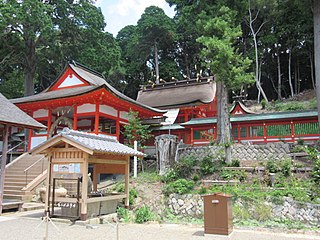
Hiro Hachiman Jinja (広八幡神社) is a Shinto shrine located in the town of Hirogawa), Wakayama Prefecture, Japan. The shrine is dedicated to the kami Hachiman. It contains a number of structures which are designated as National Important Cultural Properties. The shrine is also known for its monument to local hero Hamaguchi Goryō, who saved local villagers from a tsunami during the 1854 Ansei-Nankai earthquake, as recounted in “A Living God” by Lafcadio Hearn in his Gleanings in Buddha Fields (1897). This monument with an inscription by Katsu Kaishu and calligraphy Iwaya Ichiroku, was designated a National Historic Site in 2015.
This is the glossary of Shinto, including major terms on the subject. Words followed by an asterisk (*) are illustrated by an image in one of the photo galleries.
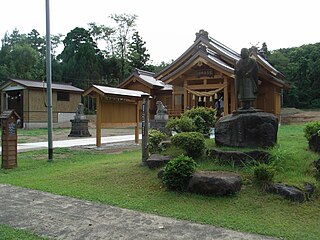
Kota Shrine is a Shinto shrine located in the Gochi neighborhood of the city of Jōetsu, Niigata Prefecture. It is one of the three shrines claiming the title of ichinomiya of former Echigo Province. The main festival of the shrine is held annually on May 3.

Takase Shrine is a Shinto shrine located in the Takase neighborhood of the city of Nanto, Toyama Prefecture, Japan. It one of four shrines claiming the title of ichinomiya of former Etchū Province. The shrine's main festival is held annually on September 13.
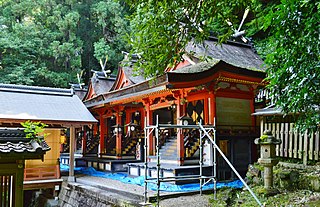
Hiraoka Shrine is a Shinto shrine located in the city of Higashiōsaka, Osaka Prefecture, Japan. It is the Ichinomiya of former Kawachi Province. The shrine's main festival is held annually on 1 February.
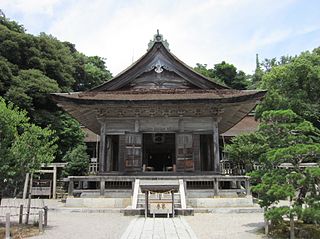
Keta Shrine is a Shinto shrine located in the city of Hakui, Ishikawa Prefecture, Japan. It was the former ichinomiya of Noto Province. The main kami enshrined is Ōkuninushi. The shrine's main festival is held annually on April 3.

Mikami Shrine) is a Shinto shrine located in the city of Yasu, Shiga Prefecture, Japan. The kami worshipped at this shrine is Ame-no-mikage-no-mikoto, Amaterasu's grandson, who in legend, descended onto 432-meter Mount Mikami during the reign of Emperor Kōrei to become the shintai of the mountain.

Aekuni Shrine is a Shinto shrine located in the city of Iga, Mie Prefecture, Japan. It is the Ichinomiya of the former Iga Province and claims to have been founded in the seventh century. It is classified as a Beppo Shrine by the Association of Shinto Shrines.

Imizu Shrine is a Shinto shrine located in the Kojo neighborhood of the city of Takaoka, Toyama Prefecture, Japan. It one of four shrines claiming the title of ichinomiya of former Etchū Province. The main festival of the shrine is held annually on April 23.

The Wakamiya Hachiman Shrine in Suehiro-chō, Sakae 3-chōme in the Naka ward of Nagoya is a historic Shinto shrine.
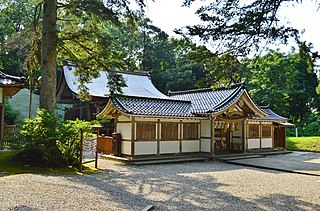
Keta Shrine is a Shinto shrine located in the Fushiki-ichinomiya neighborhood of the city of Takaoka, Toyama Prefecture, Japan. It one of four shrines claiming the title of ichinomiya of former Etchū Province, and has one of the strongest claims, as it is located in close proximity to the ruins of the provincial capital, kokubunji and the Sōja of Etchū Province, and the local place name is also ichinomiya". The main festival of the shrine is held annually on April 18.
















